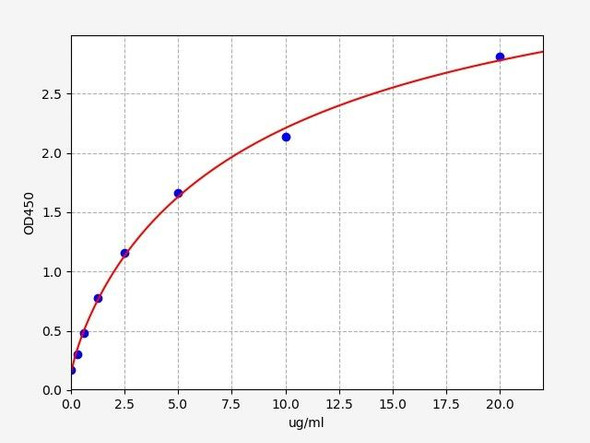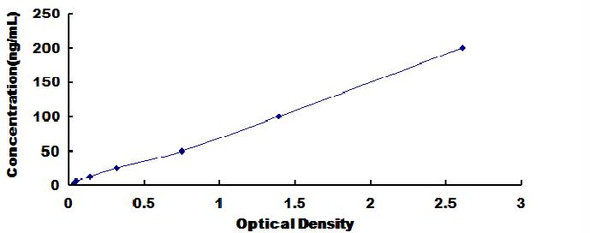Mouse Metabolism ELISA Kits
Mouse ApoB (Apolipoprotein B) CLIA Kit (MOES00084)
- SKU:
- MOES00084
- Product Type:
- ELISA Kit
- ELISA Type:
- CLIA Kit
- Size:
- 96 Assays
- Sensitivity:
- 3.75ng/mL
- Range:
- 6.25-400ng/mL
- ELISA Type:
- Sandwich
- Synonyms:
- Apo-B, FLDB, LDLCQ4
- Reactivity:
- Mouse
- Sample Type:
- Serum, plasma and other biological fluids
- Research Area:
- Metabolism
Description
| Assay type: | Sandwich |
| Format: | 96T |
| Assay time: | 4.5h |
| Reactivity: | Mouse |
| Detection method: | Chemiluminescence |
| Detection range: | 6.25-400 ng/mL |
| Sensitivity: | 3.75 ng/mL |
| Sample volume: | 100µL |
| Sample type: | Serum, plasma and other biological fluids |
| Repeatability: | CV < 15% |
| Specificity: | This kit recognizes Mouse ApoB in samples. No significant cross-reactivity or interference between Mouse ApoB and analogues was observed. |
This kit uses Sandwich-CLIA as the method. The micro CLIA plate provided in this kit has been pre-coated with an antibody specific to Mouse ApoB. Standards or samples are added to the appropriate micro CLIA plate wells and combined with the specific antibody. Then a biotinylated detection antibody specific for Mouse ApoB and Avidin-Horseradish Peroxidase (HRP) conjugate are added to each micro plate well successively and incubated. Free components are washed away. The substrate solution is added to each well. Only those wells that contain Mouse ApoB, biotinylated detection antibody and Avidin-HRP conjugate will appear fluorescence. The Relative light unit (RLU) value is measured spectrophotometrically by the Chemiluminescence immunoassay analyzer. The RLU value is positively associated with the concentration of Mouse ApoB. The concentration of Mouse ApoB in the samples can be calculated by comparing the RLU of the samples to the standard curve.
| UniProt Protein Function: | APOB: Apolipoprotein B is a major protein constituent of chylomicrons (apo B-48), LDL (apo B-100) and VLDL (apo B-100). Apo B-100 functions as a recognition signal for the cellular binding and internalization of LDL particles by the apoB/E receptor. Defects in APOB are a cause of familial hypobetalipoproteinemia type 1 (FHBL1). A disorder characterized by highly reduced plasma concentrations of low density lipoproteins, and dietary fat malabsorption. Clinical presentation may vary from no symptoms to severe gastrointestinal and neurological dysfunction similar to abetalipoproteinemia. Defects in APOB are a cause of familial ligand-defective apolipoprotein B-100 (FDB). FDB is a dominantly inherited disorder of lipoprotein metabolism leading to hypercholesterolemia and increased proneness to coronary artery disease (CAD). The plasma cholesterol levels are dramatically elevated due to impaired clearance of LDL particles by defective APOB/E receptors. Defects in APOB associated with defects in other genes (polygenic) can contribute to hypocholesterolemia. |
| UniProt Protein Details: | Protein type:Carrier; Secreted; Secreted, signal peptide Chromosomal Location of Human Ortholog: 12 A1. 1|12 3. 53 cM Cellular Component: cell soma; chylomicron; cytoplasm; cytosol; endoplasmic reticulum; endoplasmic reticulum exit site; extracellular exosome; extracellular region; extracellular space; intermediate-density lipoprotein particle; intracellular membrane-bound organelle; low-density lipoprotein particle; mature chylomicron; very-low-density lipoprotein particle; vesicle membrane Molecular Function:cholesterol transporter activity; heparin binding; lipid binding; lipid transporter activity; low-density lipoprotein receptor binding; phospholipid binding Biological Process: artery morphogenesis; cholesterol efflux; cholesterol homeostasis; cholesterol metabolic process; cholesterol transport; fertilization; in utero embryonic development; lipid catabolic process; lipid metabolic process; lipid transport; lipoprotein biosynthetic process; lipoprotein catabolic process; lipoprotein metabolic process; lipoprotein transport; low-density lipoprotein particle clearance; low-density lipoprotein particle remodeling; nervous system development; positive regulation of cholesterol storage; positive regulation of gene expression; positive regulation of lipid storage; positive regulation of macrophage derived foam cell differentiation; post-embryonic development; regulation of cholesterol biosynthetic process; response to carbohydrate stimulus; sperm motility; spermatogenesis; steroid metabolic process; transport; triacylglycerol mobilization; triglyceride catabolic process |
| NCBI Summary: | This gene product is the main apolipoprotein of chylomicrons and low density lipoproteins. It occurs in plasma as two main isoforms, apoB-48 and apoB-100. Unlike the apoB-48 and apoB-100 structural equivalents in human, which are synthesized exclusively in the gut and liver, respectively, the mouse apoB-48 isoform is also found in mouse liver. The intestinal and the hepatic forms of apoB are encoded by a single gene from a single, very long mRNA. The two isoforms share a common N-terminal sequence. The shorter apoB-48 protein is produced after RNA editing of the apoB-100 transcript at residue 2179 (CAA->UAA), resulting in the creation of a stop codon, and early translation termination. [provided by RefSeq, Jul 2008] |
| UniProt Code: | E9Q414 |
| NCBI GenInfo Identifier: | 161702988 |
| NCBI Gene ID: | 238055 |
| NCBI Accession: | NP_033823. 2 |
| UniProt Secondary Accession: | E9Q414,Q3UH74, Q497D8, Q61314, Q61318, Q8CGG8, |
| UniProt Related Accession: | E9Q414 |
| Molecular Weight: | |
| NCBI Full Name: | apolipoprotein B-100 |
| NCBI Synonym Full Names: | apolipoprotein B |
| NCBI Official Symbol: | Apob |
| NCBI Official Synonym Symbols: | apob-48; AI315052; apob-100; Apo B-100 |
| NCBI Protein Information: | apolipoprotein B-100 |
| UniProt Protein Name: | Apolipoprotein B-100 |
| Protein Family: | Apolipoprotein |
| UniProt Gene Name: | Apob |
As the RLU values of the standard curve may vary according to the conditions of the actual assay performance (e. g. operator, pipetting technique, washing technique or temperature effects), the operator should establish a standard curve for each test. Typical standard curve and data is provided below for reference only.
| Concentration (ng/mL) | RLU | Average | Corrected |
| 400 | 45838 50580 | 48209 | 48172 |
| 200 | 18260 20386 | 19323 | 19286 |
| 100 | 9229 7883 | 8556 | 8519 |
| 50 | 3904 4278 | 4091 | 4054 |
| 25 | 2113 2063 | 2088 | 2051 |
| 12.5 | 1203 1085 | 1144 | 1107 |
| 6.25 | 670 704 | 687 | 650 |
| 0 | 36 38 | 37 | -- |
Precision
Intra-assay Precision (Precision within an assay): 3 samples with low, mid range and high level Mouse ApoB were tested 20 times on one plate, respectively.
Inter-assay Precision (Precision between assays): 3 samples with low, mid range and high level Mouse ApoB were tested on 3 different plates, 20 replicates in each plate.
| Intra-assay Precision | Inter-assay Precision | |||||
| Sample | 1 | 2 | 3 | 1 | 2 | 3 |
| n | 20 | 20 | 20 | 20 | 20 | 20 |
| Mean (ng/mL) | 20.25 | 48.76 | 170.48 | 22.18 | 48.93 | 183.50 |
| Standard deviation | 2.09 | 5.46 | 17.82 | 2.55 | 4.99 | 14.22 |
| C V (%) | 10.32 | 11.20 | 10.45 | 11.50 | 10.20 | 7.75 |
Recovery
The recovery of Mouse ApoB spiked at three different levels in samples throughout the range of the assay was evaluated in various matrices.
| Sample Type | Range (%) | Average Recovery (%) |
| Serum (n=5) | 95-107 | 102 |
| EDTA plasma (n=5) | 101-113 | 107 |
| Cell culture media (n=5) | 85-98 | 91 |
Linearity
Samples were spiked with high concentrations of Mouse ApoB and diluted with Reference Standard & Sample Diluent to produce samples with values within the range of the assay.
| Serum (n=5) | EDTA plasma (n=5) | Cell culture media (n=5) | ||
| 1:2 | Range (%) | 94-111 | 100-114 | 103-115 |
| Average (%) | 102 | 107 | 109 | |
| 1:4 | Range (%) | 104-117 | 89-104 | 103-116 |
| Average (%) | 110 | 96 | 109 | |
| 1:8 | Range (%) | 93-106 | 90-104 | 90-105 |
| Average (%) | 100 | 96 | 96 | |
| 1:16 | Range (%) | 91-105 | 102-116 | 97-110 |
| Average (%) | 96 | 109 | 103 |
An unopened kit can be stored at 4°C for 1 month. If the kit is not used within 1 month, store the items separately according to the following conditions once the kit is received.
| Item | Specifications | Storage |
| Micro CLIA Plate(Dismountable) | 8 wells ×12 strips | -20°C, 6 months |
| Reference Standard | 2 vials | |
| Concentrated Biotinylated Detection Ab (100×) | 1 vial, 120 µL | |
| Concentrated HRP Conjugate (100×) | 1 vial, 120 µL | -20°C(shading light), 6 months |
| Reference Standard & Sample Diluent | 1 vial, 20 mL | 4°C, 6 months |
| Biotinylated Detection Ab Diluent | 1 vial, 14 mL | |
| HRP Conjugate Diluent | 1 vial, 14 mL | |
| Concentrated Wash Buffer (25×) | 1 vial, 30 mL | |
| Substrate Reagent A | 1 vial, 5 mL | 4°C (shading light) |
| Substrate Reagent B | 1 vial, 5 mL | 4°C (shading light) |
| Plate Sealer | 5 pieces | |
| Product Description | 1 copy | |
| Certificate of Analysis | 1 copy |
- Set standard, test sample and control (zero) wells on the pre-coated plate and record theirpositions. It is recommended to measure each standard and sample in duplicate. Note: addall solutions to the bottom of the plate wells while avoiding contact with the well walls. Ensuresolutions do not foam when adding to the wells.
- Aliquot 100µl of standard solutions into the standard wells.
- Add 100µl of Sample / Standard dilution buffer into the control (zero) well.
- Add 100µl of properly diluted sample (serum, plasma, tissue homogenates and otherbiological fluids. ) into test sample wells.
- Cover the plate with the sealer provided in the kit and incubate for 90 min at 37°C.
- Aspirate the liquid from each well, do not wash. Immediately add 100µL of BiotinylatedDetection Ab working solution to each well. Cover the plate with a plate seal and gently mix. Incubate for 1 hour at 37°C.
- Aspirate or decant the solution from the plate and add 350µL of wash buffer to each welland incubate for 1-2 minutes at room temperature. Aspirate the solution from each well andclap the plate on absorbent filter paper to dry. Repeat this process 3 times. Note: a microplatewasher can be used in this step and other wash steps.
- Add 100µL of HRP Conjugate working solution to each well. Cover with a plate seal andincubate for 30 min at 37°C.
- Aspirate or decant the solution from each well. Repeat the wash process for five times asconducted in step 7.
- Add 100µL of Substrate mixture solution to each well. Cover with a new plate seal andincubate for no more than 5 min at 37°C. Protect the plate from light.
- Determine the RLU value of each well immediately.






